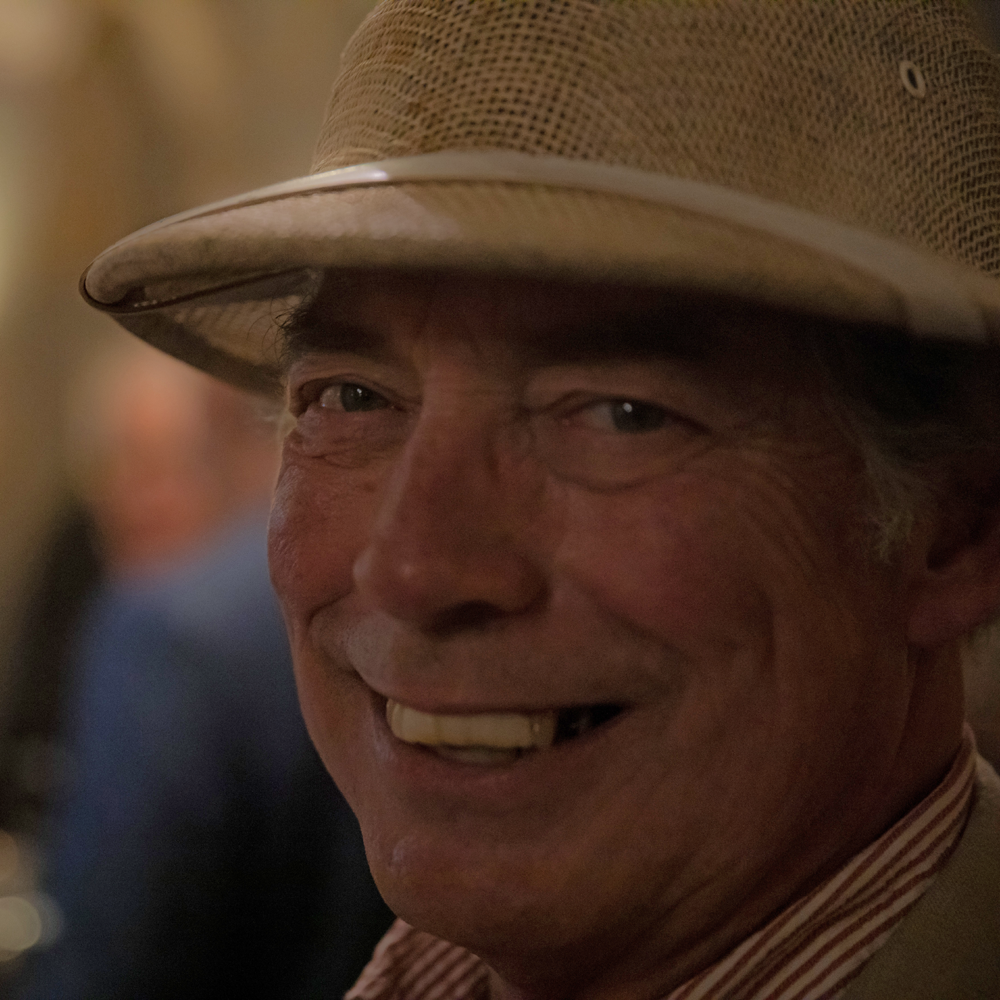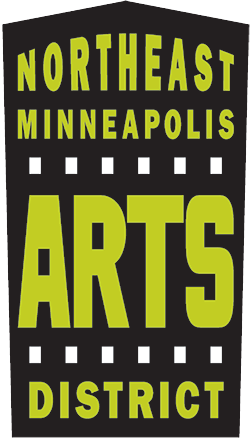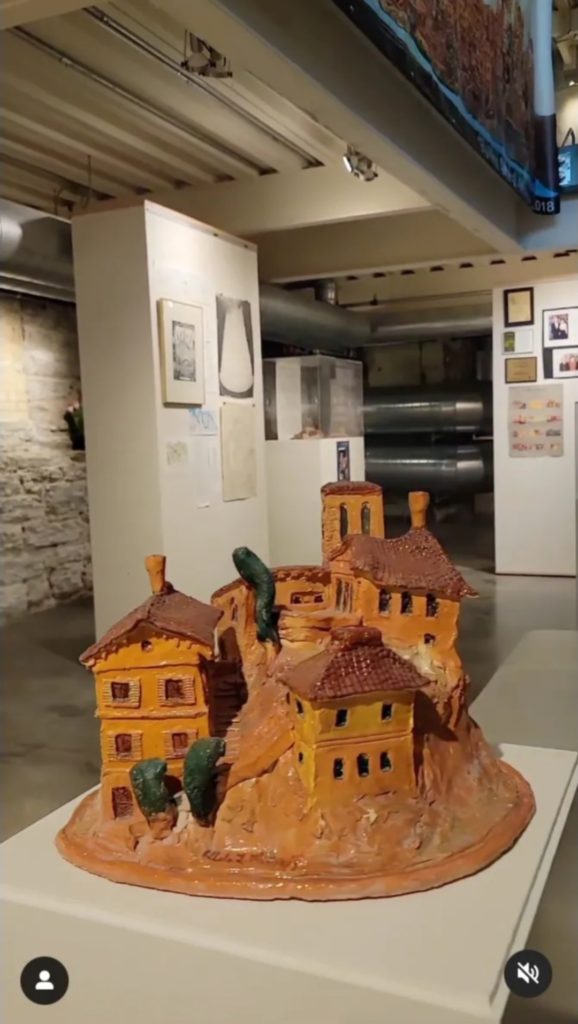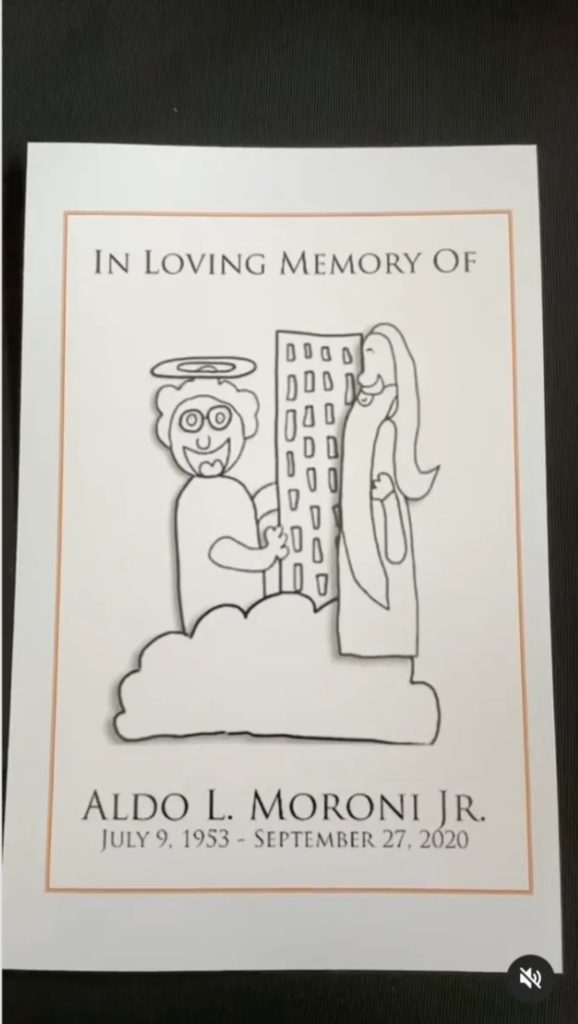
July 9, 2022, friends and family held an afternoon open house in Aldo Moroni’s honor. Aldo passed away on September 27, 2020 of pancreatic cancer, one of many to be celebrated first in private family gatherings (Naperville, Illinois) followed by more public events once the COVID-19 pandemic was better understood.
Aldo’s art made big statements through pageantry, so it is not surprising his tribute include a parade (with brass instruments) around the Mill District near A-Mill Artist Lofts where he lived since the building opened. (The photo of him at A-Mill, above, dates back to 2016, by Scott Amundson for Minneapolis & Saint Paul Home Tour.)
The following are two videos recorded during the Aldo Moroni’s Memorial celebration.
A look back on a beloved artists
Here’s a look back on his life in a history printed nine months before he died:
In November 2018, Aldo Moroni sat in the California Building lobby in pith helmet and other explorer gear, laptop cord strung to an awkward outlet, animatedly holding court on the Mesoamerican experience – hundreds of years of Mexican history to present day.
Like Gloria Civita, his clay project of the late 1980s, or Babylon of 2003-2009, or Trumptopia from 2017, some of Moroni’s complex small cities take years to build. They involve everyday folks in the building, and folks who watch as he, with twinkle in eye, assumes the position of emperor – in full regalia – and destroys all or part of his civilizations real or imagined. He’s well-grounded in architecture and history, voraciously researching as he did in this past year.
His works contain “sly social messages,” in the words of art critic Mary Abbe. Some are simply joyful, particularly Moroni’s interactive works from art residencies in elementary schools.
 At events Fridays, Nov. 1 and Nov. 8, 2019, to packed rooms of long-time friends, followers and well-wishers, this giant who is average in physical stature, climbed a couple stairs to a lecture platform. He started with jokes and eventually focused on a couple of fundraising items, ceramic cups and codex books, to fund this epic and the space. It’s called the Legacy Makers Place, at #113 in the California Building, just off the loading dock, and it’s yet to be totally defined. Lisa Roy has been hired to figure it out.
At events Fridays, Nov. 1 and Nov. 8, 2019, to packed rooms of long-time friends, followers and well-wishers, this giant who is average in physical stature, climbed a couple stairs to a lecture platform. He started with jokes and eventually focused on a couple of fundraising items, ceramic cups and codex books, to fund this epic and the space. It’s called the Legacy Makers Place, at #113 in the California Building, just off the loading dock, and it’s yet to be totally defined. Lisa Roy has been hired to figure it out.
He explained that the Mexicans made many-folded books, called codex, with all of their information … 100,000 or more were recorded. After all the battles and burnings, fewer than 20 exist “and only four of them have been verified.”
Moroni made his own book, The Synoptic Codex of Mesoamerica, in collaboration with Justine Tucker. It’s a much abridged history that includes the fact that November 8, 2019 was the 500th anniversary of the first meeting of the emperor Montezuma and the Spanish conqueror Cortés at Tenochtitlán. Prior to that meeting, three peoples had come together to form a complex civilization. After, “within two years, everyone was speaking Spanish.”
“Who knows what would have happened if Montezuma hadn’t been such a wimp,” said Moroni, comparing conqueror Cortés to “a certain president you may know.” The codex, selling 150 limited edition copies for $500, concludes with The Donald building the wall.
“We put their babies in cages, the most disgusting travesty. Mexico City is beautiful, it has more museums than any city in the world. So I had to tell this story, I had to build this. And I was going to build it all myself,” from the temples to the houses.
During his talk, Aldo Moroni had tossed out what many already knew from advance press, the announcement that he has inoperable, incurable late-stage pancreatic cancer, an unexpected wrinkle in his grand scheme. “I won’t be around to finish this. You all are going to have to finish it,” he said. “In other cultures, all people make things. All people dance. This is social art. Anyone can do what I do.” Moroni said he would like to see history re-written in this scenario, “what if Montezuma had poked Cortés’ eyes out? Blind Cortés!”
He reflected in an interview that his personal story and the Mesoamerican story have parallels. “The culture was humming along, with great advances in all fields, then bam! It’s the finality of the planet, too; pay attention! This is for real, it has happened before.”
Early days, history in NE
The Walker Art Center gave Moroni exposure in a group show when fresh out of MCAD, the Minneapolis College of Art and Design. An article on his tile work for the Federal Reserve noted that he arrived by train in 1972 from Chicago to attend the school. He’d been part of the artist community at a building called the Skunkhouse immediately behind the Fed building.
In a 1982 article in the St. Paul Dispatch, Moroni is pictured “balancing a son, a cigarette and a palette knife.” The sculpture, in wax at that time, was “The Tower of Babel,” its pedestal three boxes of empty Leinenkugel bottles.
By the mid-1980s Moroni was able to make a living solely through his art and even gave one-third of the proceeds from one show to the Juvenile Diabetes Foundation. “Art is often a completely closed and self-serving world,” he told Mary Abbe Martin in 1985. “I think it is time to bring a new humanitarianism to the arts … people just have to take action. There’s a tradition of alienation in the arts that’s 200 years old, but there’s a bigger 4,000-year-old tradition of artists being involved in society. That’s what I think should be revived.”
Aldo’s been part of the Eastside and Northeast Minneapolis arts scene for a large portion of his 45-year career. His first studio after having to leave downtown was in 1986 in the Olson Building (which is now Q.arma, then an “industrial hovel”) on Quincy Street, living in a Northeast apartment, in a relationship, having his first two kids.
He was working for Wilensky Arts in what is now North Loop, when he won several big foundation awards and moved out to Avon, Minnesota for a year. “My wife [Sarah] got fed up, so here I was packing my stuff up and back to Northeast. His studio ended up in the St. Anthony Main area, “an empty building almost to myself.” A second marriage [Kim], a daughter, three more sons, and a home in Audubon neighborhood…eventually divorce.
Aldo stayed involved in Northeast managing a gallery space at the California Building and working on his Babylon project. Growing up, his family was in restaurants, so “that was always the fallback,” at any time there weren’t enough public or private commissions, theater set projects or teaching gigs. “I could always tend bar. And my friends would come drink at my bar.”
Aldo now lives at the A-Mill lofts where The Journal writer Susan Schaefer dubbed him its “undisputed dean.” “It’s my dream version of Minneapolis, really, all the way up the river; it’s way cooler than the lakes,” Moroni said.
In 2016, shortly after the building opened, he organized a handful of other artists to join him in opening their residences to the Minneapolis & Saint Paul Home Tour. The location topped the attendance charts. Anytime he’s around, he’ll happily give tours. Part of his joy at A-Mill is having his youngest, his twin adult sons with him.
 In the early 2000s, Marcy Holmes neighborhood commissioned Moroni’s series of 23 bronze sculptures, the 6th Avenue Stroll from University Avenue to Main Street, a project that took longer and a bit more money than originally budgeted. A Southeast Angle article quipped that the delay just made them more historic.
In the early 2000s, Marcy Holmes neighborhood commissioned Moroni’s series of 23 bronze sculptures, the 6th Avenue Stroll from University Avenue to Main Street, a project that took longer and a bit more money than originally budgeted. A Southeast Angle article quipped that the delay just made them more historic.
His “Mill City Dance” at the Cedar Riverside Light Rail Station was at first rejected and eventually installed in 2004 after a dispute over fabrication agreements was resolved. For approximately half of the artists commissioned for light rail projects, the process did not go as planned.
In 2017, Aldo received a Northeast Minneapolis Arts District Vision Award.
Moroni reflected to his friends Nov. 1: “For me to be a part of this community, what a joy. It’s a real community … you build it, and if you don’t buy my art, buy somebody else’s art.” In classic Aldo, he admonished, “but buy mine first.”
In his Northeaster interview, Moroni had this to say, talking mostly about the sentiment building for establishing an arts center, “To my neighbors in Northeast: take a chill pill, lighten up, move in one direction. If everyone were in a conversation, you could manage your own town. Don’t get yuppified beyond recognition. The opportunity is on the plate in front of us.
“What a gas, to be here. It’s been a good ride.”
[article by Margo Ashmore, published in Northeaster November 2019]


